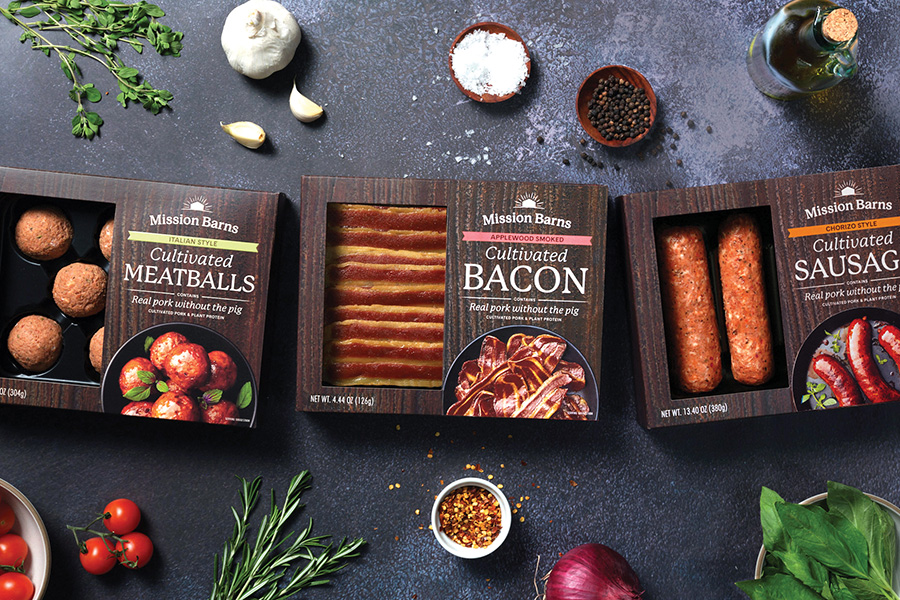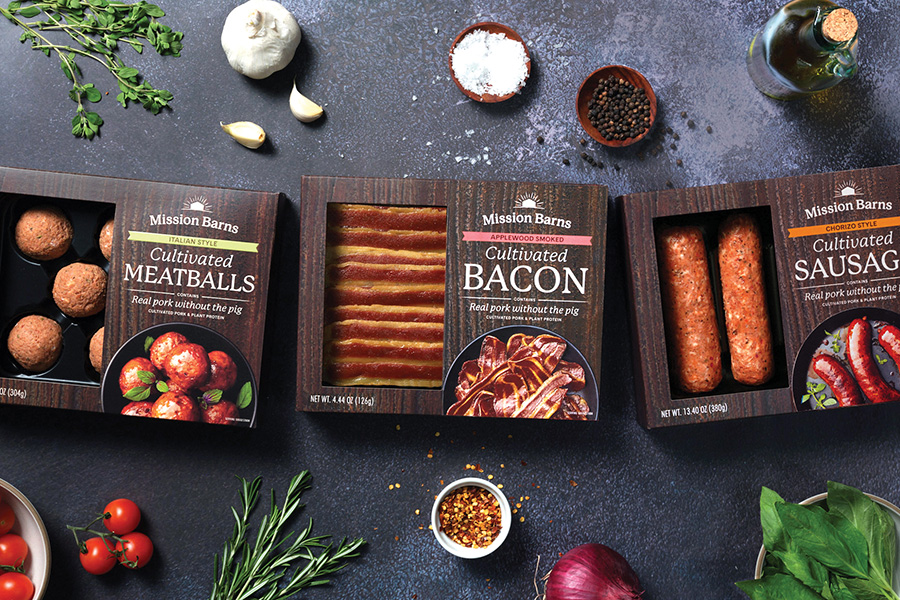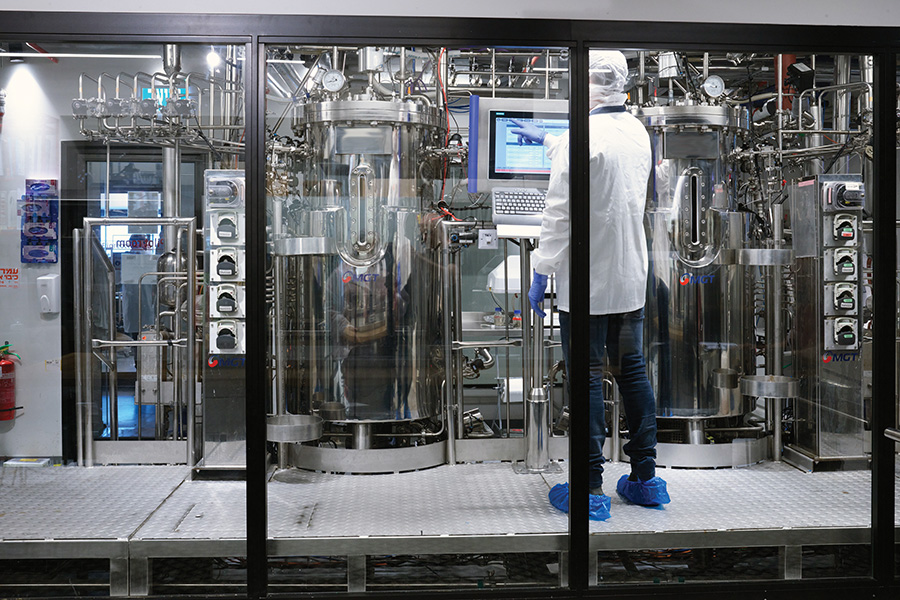How Eco-Friendly Is Cultivated Meat?
With the United States on the cusp of cultivated meat commercialization, debate surrounds its potential impact on progress toward net zero food production.

Cultivated meat is on its way to a major tipping point: the culmination of decades of development and the beginning of a vast potential market. Venture capitalists, governments, and tech moguls have poured billions of dollars into more than 100 startups whose collective goal is to replicate animal flesh in laboratories and bioreactors and give it the characteristics—and prices—of natural meat. Advocates believe they’ll also reduce the impact of animal agriculture on Earth’s climate.
But will cultivated meat actually follow a successful trail like other seminal technologies, such as personal computers, which democratized digital productivity and communication, and electric vehicles, whose inevitability has arrived thanks to cultural pressures and government mandates more so than the readiness of the technology?
Or will cultivated (aka cell-cultured or cell-based) meat be held back perpetually by the major challenges it still faces in triumphing over the consumption experience, production costs, carbon footprint, and economic and social roles of actual meat—teasing revolutionary possibilities but coming up short of initial promises much like its predecessor, plant-based meat?
“There is excitement for it,” says Elizabeth Gutschenritter, managing director of alternative protein for global agriculture giant Cargill, which has invested in cultivated meat pioneers. “Some consumers will want to be on the cutting edge of food technology. But we need to make sure it can live beyond the novelty of what cultivated meat can offer today.”
Some believe cultivated analogues could succeed in proving even better than natural meat. “The consumer wants to see evolution,” says Leticia Gonçalves, president of global foods for ADM, another major ag player that is backing some cultivated meat startups. “Not just mimicking of animal meat. Not just plant-based burgers that are the same as they can get with animal meat. They want better nutrition and health benefits. It’s about introducing a new food experience, maybe like a ‘good health’ burger.”
Projections of global market size for cultivated meat include McKinsey’s $25 billion by 2032. But like many cutting-edge business propositions these days, at this point, cultivated meat is largely a bet on unrelenting societal pressures for environmental mitigation.
Environmental Issues
Livestock production contributes an estimated 18% of anthropogenic greenhouse gas emissions, is a major contributor to water stress, and is a key driver of deforestation around the globe, environmental advocates point out. Current research indicates that cultivated meat could cut land use by 94% to 99% compared with traditional livestock production, reduce water consumption by 82% to 96%, and slash greenhouse gas emissions by 78% to 96%, according to Rosalyn Abbott, an assistant professor in biomedical engineering and materials science and engineering who is working on cultivated meat at Carnegie Mellon University.
The new industry’s environmental narrative hasn’t gone unchallenged. Advocates say that a mature cultivated meat industry will provide improvement of up to 45% in energy efficiency compared with livestock production, according to Abbott. But a recent study by the University of California, Davis, questioned this basic assertion. After conducting a cradle-to-grave life cycle assessment of animal cell–based meat, the researchers concluded that “current production methods” lead to a greater global warming potential than beef production because making cultivated meat in bioreactors is more resource intensive. While warming caused by methane from livestock emissions ceases after a few decades, carbon emissions from the manufacture of cultivated meat would persist.
The cultivated meat industry has pushed back mightily against the study by UC Davis. “The assumption they made for their worst-case scenarios is that you’d have to use pharma-grade purification of media, and that’s not what’s happening in this industry,” says Elliot Swartz, principal scientist for the Good Food Institute, a think tank focused on alternative protein advancements. Other industry participants note that many cultivated meat plants are being constructed to use alternative energy sources, such as solar power, that will cut carbon emissions compared with conventional manufacturing plants.
And, says Kristala Jones Prather, a chemical engineering professor at Massachusetts Institute of Technology, cultivated meat facilities have the advantage of “being able to scale not just out, but also up. With animals that are grazing, you can’t go up, but theoretically you could have very large reactors that would allow you to scale in that direction.”
Meanwhile, continued expansion of livestock production isn’t tenable, despite improvements such as relying on regenerative agriculture practices and new feed types that cut cattle’s methane emissions, cultivated meat advocates say.
Shifting climate conditions are likely to “change the price of our food, mostly with meat becoming more expensive and less available,” says Niya Gupta, cofounder and CEO of Fork & Good, a cultivated meat startup. Earlier in her career, she helped set up feedlots for the beef supply chain in Africa. “We will have less feed for animals and more heat stress on them. So the price of meat will be going up at the same time the world is demanding more of it.
“The one percent will always be able to buy the meat that they want,” says Gupta. “But it’s about the average person. We need some buffer and some way of hedging. Will the price of the average pepperoni pizza go up? Will people still regularly get to eat meat?”
In addition to getting crucial credit for their environmental bona fides, cultivated meat companies believe consumers will overcome hesitations about the authenticity and provenance of their products, especially as retail pricing pulls into eventual parity with meat. So it’s little surprise that hype around cultivated meat prospects already has gotten out of hand among consumers who’ve come to anticipate the next new “it” technology. One recent survey said that 11% of Americans claim that they have already tried and liked cultivated meat, which, of course, is impossible.
“Any alt-meat product has to compete on price and taste with the consumer,” says Swartz. “Products have to come to the marketplace and wow the consumer or they won’t get repeat purchase.”
Skeptics and Supporters
Indeed, it isn’t just the environmental proposition of cultivated meat that raises questions. “What is the consumer problem that these products are trying to solve?” asks Julian Mellentin, editor of New Nutrition Business, who also was an early doubter about the market for plant-based meat substitutes, which has gotten shakier than its backers had hoped. “In what way will they be competitive? Offering something which is a substitute, how will it prompt people to make the shift?”
Outright opponents of cultivated meat include the Italian government, which has approved a draft bill banning the production and commercialization of cultivated meat for human and animal consumption. The bill set out to preserve the Italian food and culinary heritage and followed a petition launched by a national farmers’ association against “synthetic foods.”
With tremendous development and scaling costs facing them right now and eventual revenue streams at least a few years away, a shakeout already has begun among startups. New Age Eats, for example, made what founder and CEO Brian Spears called the “painful decision” to shut down recently after failing to secure funding to complete work on its pilot facility in California. Spears had raised $32 million for the pork-alternative startup he founded in 2018.
But at the same time, cultivated meat already has achieved traction in important ways. Patrons at some restaurants in Singapore today are consuming “chicken” that became the world’s first cultivated meat commercial product in 2020, a development that attracted many cultivated meat startups to the island nation.
And importantly, the U.S. Food & Drug Adminis-tration, a bellwether food safety agency for the world, recently approved applications by UPSIDE Foods and Eat Just to sell their chicken analogues. UPSIDE is backed by high-profile interests ranging from the sovereign fund of Abu Dhabi to Bill Gates and Richard Branson; Eat Just is the brainchild of Josh Tetrick, who’s been a major player in alt-proteins for many years.
Indeed, not just startups and governments but also traditional food giants have been pouring resources into cultivated meat investments. “We need to stay close to the consumer and offer them what they’re wanting in the future of food,” explains Cargill’s Gutschenritter. “So we view our role as being able to unlock the broad value chain we operate in today and being able to partner externally.”
Entrepreneurs have talked about developing cell-cultured versions of relatively exotic livestock ranging from ostriches to kangaroos, where they could do away with the significant challenges of raising the animals as food. But global mainstream animal lines—chicken, pork, beef, and lamb—are where the sizzle is for cultivated meat although cultivated seafood also has huge potential.
How It’s Done
Many companies employ precision fermentation to produce growth factors for the cell culture media for these products. Precision fermentation is the process of engineering the gene sequence for a specific protein into a bacterium or yeast strain and then growing that strain in large-scale fermenters to produce the required protein, something that has been harnessed by producers of faux eggs and dairy products as well as by companies such as Meati that use “solid-state fermentation” to tease fungi into their own alt-meats.
Cultivating meat uses stem cells from live animals, nurturing it into tissue that keeps replicating in fermenters, called bioreactors, and eventually into blobs that resemble ground meat. In more complex applications, startups are combining muscle cells with fat and bone cells as “microcarriers” and components of “scaffolding” to use 3-D printing to replicate cuts of meat from chicken breasts to Wagyu steaks.
Believer Meats is typical of “full-stack” vertically integrated cell meat companies, using what it calls “immortalized” stem cells that can proliferate indefinitely, explains Yaakov “Koby” Nahmias, founder and president of the startup that is backed by Tyson Foods and ADM, among others.
Nahmias says his company was the first cultivated meat player to build a pilot facility, which it did in 2021, and construction of a large-scale factory is in the works. Believer plans to make its North Carolina–based facility operational by the second half of 2024, first producing chicken analogues and eventually lamb and beef too.
“We want to make sure we can build factories and bring products to consumers at the earliest possible time,” Nahmias says. “We’re not talking about one restaurant and one chicken nugget at a time but talking about supermarkets and at scale.”
Pricing will be in line with organic chicken, he says. “If you’re making lamb chops, that already is a premium item, and we don’t necessarily have to be priced above them. The same thing with steaks,” Nahmias explains. “Organic chicken is an interesting benchmark to be at because it’s still in the frame of reference for most consumers.”
Another promising approach is for startups to limit their efforts to particular components of meat imitation. Fork & Good, for instance, is focusing on muscle tissue at its new pilot facility in Jersey City, N.J., to produce a ground pork analogue that Gupta says is “targeting price parity with Walmart antibiotic-free pork.”
Meanwhile, Mission Barns is working on cultivating fat from porcine stem cells. Founded by Eitan Fischer, former head of the cultivated meat division of the predecessor company of Eat Just, Mission Barns is fashioning pork fat into the main component of analogues of meatballs, bacon, and sausage that are in a pilot test in restaurants and retail stores in the San Francisco Bay Area. “Fat, we know, is the most scalable approach,” says Laura Burch, communications director for Mission Barns. “It’s fat that drives juiciness and mouthfeel.”
Mission Barns also is pursuing a strategy that has become increasingly common among cultivated meat pioneers as they seek reasonable costs: combining some of their cells with plant-based ingredients. “We have proprietary consumer insights showing that almost 50% of consumers would be interested in trying plant-based-plus-cultivated hybrids, things that have soy protein with cultivated meat as an ingredient,” says ADM’s Gonçalves.
Challenges to all players include the sheer complexity of the production systems they must create and scale. “It’s an orchestration of a lot of different technologies that have to work together at once,” says Johnny Ream, partner in Stray Dog Capital, a venture firm with cultivated meat investments. “It’s so challenging.”
Cultivated Meat Economics
The astronomical cost of crucial growth media poses the biggest obstacle as manufacturers scale up. So far, they’ve had to use very expensive, pharmaceutical-grade media that’s composed of a complement of amino acids, vitamins, inorganic salts, glucose, and serum as a source of growth factors, hormones, and other crucial components for fostering cell development.
Yet on this crucial front, the cultivated meat industry claims steady progress because suppliers are developing less expensive, food-grade media. “I’ve spoken to many of the world’s leading culture-media companies, and they all said they’re already incorporating many food-grade ingredients into their media formulations,” says Swartz of the Good Food Institute.
Cultivated meat backers are counting on governments to advance their cause through regulatory product approvals and even R&D initiatives and financing. Already, the U.S. government has been offering multimillion-dollar grants to some cultivated meat startups, and it established a new National Institute for Cellular Agriculture, launching a bit of a “space race” in the sector.
“Compare these investments to government investments in alternative energy, and it’s tiny,” says Ream. “But over time, as technologies play out and we continue to showcase what can be done with cell meat in terms of production costs, more dollars will flow from government sources. It completely changes the nature of the food system.”
Ultimately, sales of cultivated meat and support for the industry will boil down to consumption behavior. In a 2021 Good Food Institute survey often quoted by cultivated meat companies, 80% of consumers said they would be “somewhat likely” to try cultivated meat once it becomes available, with only about 20% saying they wouldn’t be willing to do so.
Popular support for climate change mitigation is an important component of those sentiments. “People feel the heat waves around them and know their behavior is affecting climate as well as the well-being of animals,” Nahmias says. “They know demand for meat is affecting the future of our children, so there is strong interest.”
Yet consumers often talk a good game about the importance of sustainability but then forget about it behind their shopping carts, especially in times such as now when high food inflation has shoppers watching their wallets. This year, “sustainability” came in at No. 5—below taste, price, healthfulness, and convenience—in a list of what American food consumers want, according to an annual survey by the International Food Information Council.
To even get consumers to consider the purported environmental benefits of their cultivated meat purchase, cultivated meat will have to perform well on those other criteria. “It’s a matter of introducing them to it and being transparent about what’s going into it,” maintains Abbott of Carnegie Mellon University, who heads a team that is working on 3-D printing of Wagyu steak analogues.
Companies are trying to add nutrients to their cultivated products such as B vitamins, iron, and zinc, which are importantly provided by animal meat. But, notes Mellentin, “currently there is no evidence that lab meat will be absorbed in the human body in the same way as protein from plants, dairy, or animal meat.”
The simple question of provenance will be an obstacle for some consumers. In contrast to the Good Food Institute survey, a 2022 study published in The Journal of Environmental Psychology found that 35% of meat eaters and 55% of vegetarians would be too disgusted to try cultivated meat. “People are a little uneasy about it,” says Tom Bailey, senior consumer foods analyst for Rabobank. “‘What really is this?’ But ultimately, people [will] come around to the idea.”
Big vested interests mean to help shoppers along. “We’re continuing to help consumers to understand the benefits of eating cultivated meat and being part of a growing ecosystem that will help feed our growing population,” says Gonçalves of ADM. “We need to make sure we can make consumers understand.”ft


















